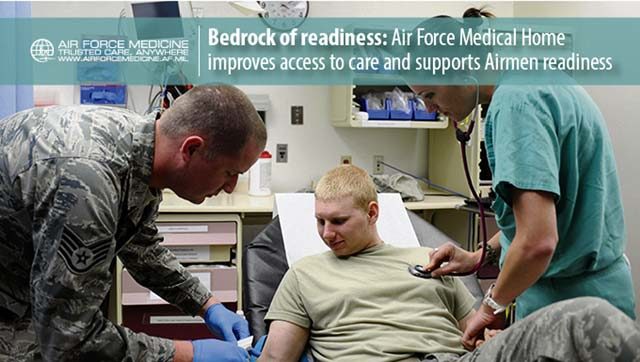
FALLS CHURCH, Va. — Air Force Medical Home is a patient-centered, team-based approach to delivering primary care to patients at Air Force health facilities. As with all aspects of the Air Force Medical Service mission, maintaining Airmen’s medical readiness and optimizing performance is the highest priority. To achieve this mission, the Air Force Medical Service is working to increase its health care capabilities, and provide greater levels of mission support to line commanders.
“The bedrock of our readiness is the Air Force’s military medical centers, and clinics,” said Col. Zina Crump, Special Assistant to the Air Force Surgeon General for integration of AFMH. “Air Force Medical Home directly enables the medical readiness of today’s warfighters, provides Trusted Care to Airmen and their families, and keeps our medics deployment ready.”
AFMH supports Airmen readiness through several improvements to health care delivery. The most significant of these is removing barriers to care. With the primary care clinic positioned as the entry point to their health care, patients can easily access the right level of care they need. Transforming care in this way makes it easier to provide preventative care, which has a positive impact on patients.
“Research indicates that patients in medical home-style clinics make fewer trips to the emergency room and have fewer overall hospitalizations,” said Crump. “It has also shown to improve physician-patient relationships and reduce overall cost of care.”
The AFMS care model also makes it easier to coordinate care with specialists using a team-based approach. Patients can easily get referrals to specialists it and know that their care is organized and coordinated across the health care system.
“Specialists, mental health experts, physical therapists, clinical pharmacists, social workers, and others are embedded in to the primary care clinics,” explained Crump. “They work closely together and deliver quality care for each patient.”
This team-based approach also helps keep health care providers and staff fresh during times of high workload, ensuring a high level of patient care. Since fatigue and burnout can be significant factors that can impact patient care, this is critical.
“Leadership at all levels realize the importance of our medical homes, and many initiatives are currently under investigation to better balance that workload,” said Col. Kyle Hudson, AFMH Branch Chief. “Ultimately, improved staff satisfaction leads to less staff turnover, better patient service, and higher quality primary care.”
To improve workload and communication within and among health care team, the AFMS is employing various electronic tools.
“In addition to the implementation of electronic medical records, AFMH clinics have developed what we call ‘virtual visits,’” said Hudson. “These visits are scheduled telephone encounters with the primary care manager and are meant to be more convenient for established patients with concerns that can be assessed and managed over the telephone.”
AFMH also incorporates secure messaging that allows patients to communicate electronically with their health team, and receive non-urgent health advice at their convenience. These tools have made it easier for patients to gain access to the care they need.
The future direction of AFMH is transforming the way health care is being delivered and improving ways to better support the mission. In addition to improved patient access to care, it is vital that the AFMS continues to grow to meet readiness requirements.
“Missions vary from installation to installation and medical teams will be customized to meet mission and other support requirements for each installation,” said Crump. “One model does not fit all and the AFMH will continue to evolve to align with the Air Force’s vast mission set.”


